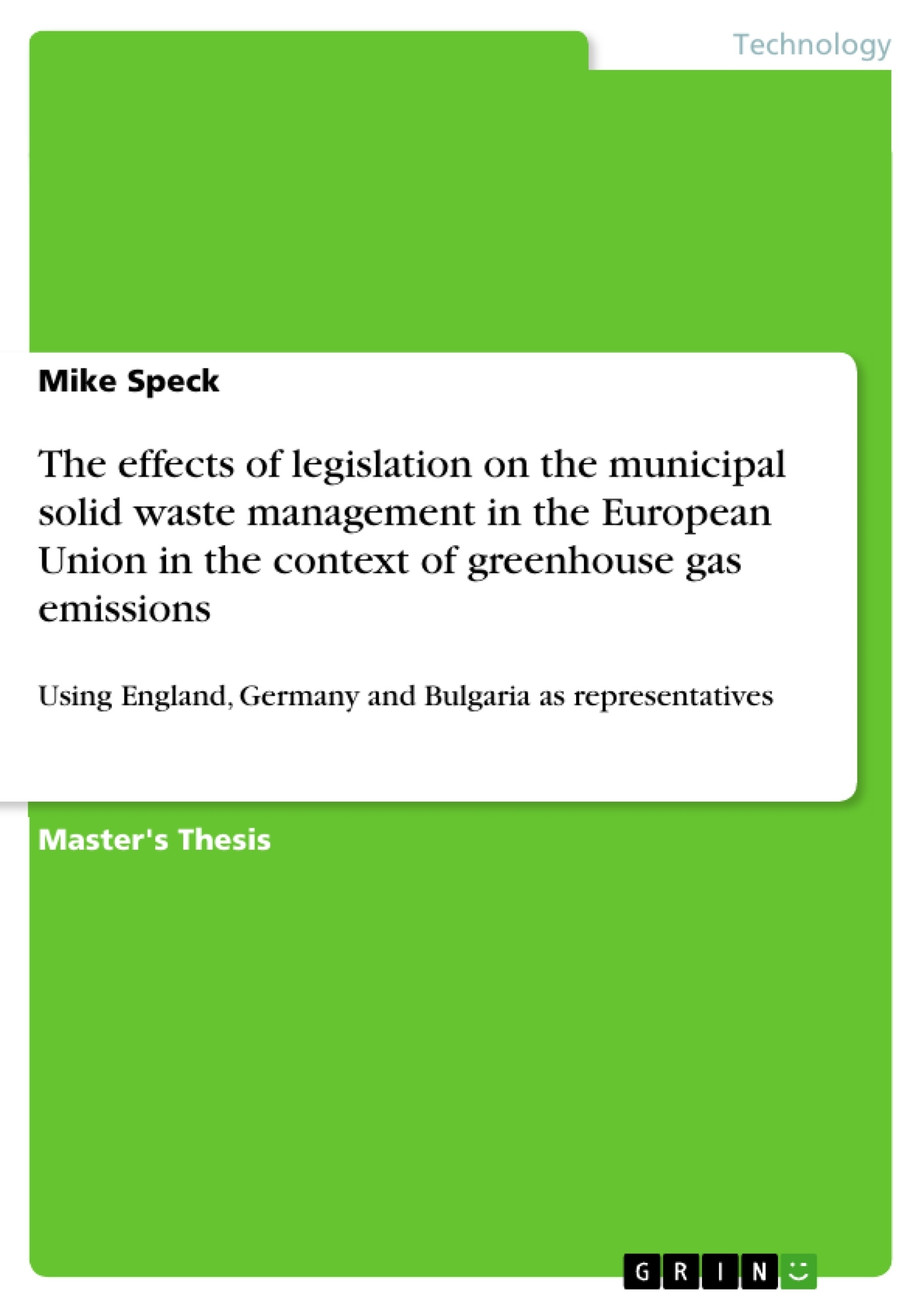Since the pre-industrial era the concentration of carbon dioxide in the atmosphere has increased by nearly 30%, methane concentrations have more than doubled. The resulting climate change will lead to major environmental changes such as rising sea levels, shrinking mountain glaciers, the spread of infectious diseases and increased heat related mortality, impacts to ecosystems and loss in biodiversity, and agricultural shifts such as impacts on crop yields.
As this increase is at least partly caused by human activity, the effort to confront anthropogenic greenhouse gas emissions has increased over the last years. Probably the most important measure implemented is the Framework Convention on Climate Change.
In the EU about one third of manmade methane emissions, with a global warming potential 21 times greater than that of carbon dioxide, can be attributed to solid waste disposal. With some 60% of municipal solid waste still being disposed of to landfill without any form of pre-treatment and extensive reliance on incineration for treatment of most of the remainder, it is clear that there is considerable scope for improvement.
In this report the capability of either European or national legislation to improve the actual situation on greenhouse gas emissions related to the management of municipal solid waste was investigated by using England, Germany and Bulgaria as representatives.
From the results obtained by applying a LCA it becomes obvious that European legislation will improve the actual situation on the management of municipal solid waste. The greenhouse gas emissions generated in England will be reduced by more than 75% and thus result in a negative greenhouse gas flux. In Bulgaria the emissions will decline by more than 82%.
With regard to the waste management hierarchy the greatest improvements will be reached by reducing the amount of biodegradable municipal solid waste from landfilling and meanwhile focusing on material recycling. To deal with the putrescible fraction biological treatment options should be preferred to thermal treatment methods.
All improvements achieved by the different scenarios are based on effective source segregated collection schemes. This measure could be justified by the fact that most treatment options rely significantly on the quality of the input materials and that in comparison with the whole municipal solid waste management emissions based on collection and transportation could be neglected.
Inhaltsverzeichnis (Table of Contents)
- Abstract
- Introduction
- Objectives
- Aim
- Literature Review
- Life Cycle Assessment
- Technologies
- Material Recovery Facilities
- Biological Treatment
- Thermal Treatment
- Landfilling
- Recycling
- Actual Situation
- England
- Germany
- Bulgaria
- Scenarios
- England
- Germany
- Bulgaria
- EU Legislation
- Council Directive 1999/31/EC
- England
- Germany
- Bulgaria
- Directive 2004/12/EC
- England
- Germany
- Bulgaria
- Council Directive 1999/31/EC
- National Legislation
- England
- Germany
- Bulgaria
- Technologies
- Results and Discussion
- England
- Germany
- Bulgaria
- Conclusions
Zielsetzung und Themenschwerpunkte (Objectives and Key Themes)
This dissertation explores the effectiveness of European and national legislation in mitigating greenhouse gas emissions generated from municipal solid waste management practices. Using England, Germany, and Bulgaria as case studies, it analyzes the impact of legislation on various waste management approaches, such as landfilling, incineration, recycling, and biological treatment, with the goal of identifying areas for improvement and potential solutions.
- The impact of legislation on greenhouse gas emissions related to municipal solid waste management
- The effectiveness of different waste management strategies in reducing greenhouse gas emissions
- The role of source segregation and recycling in minimizing waste generation and emissions
- The comparison of waste management practices across England, Germany, and Bulgaria
- The potential for improvement in waste management practices to reduce greenhouse gas emissions
Zusammenfassung der Kapitel (Chapter Summaries)
The dissertation begins with an introduction outlining the objectives and aim of the study. It emphasizes the significance of mitigating greenhouse gas emissions caused by waste management practices and highlights the need for effective legislation to promote sustainable waste management practices.
The chapter "Literature Review" explores existing literature on the subject of waste management and its environmental impacts. It examines various approaches to waste management, including landfilling, incineration, recycling, and composting, and analyzes the associated greenhouse gas emissions.
The chapter "Life Cycle Assessment" delves into the application of Life Cycle Assessment (LCA) methodology to evaluate the environmental impacts of different waste management options. It presents a detailed analysis of various technologies, including material recovery facilities, biological treatment, thermal treatment, landfilling, and recycling, and discusses the current situation in England, Germany, and Bulgaria regarding waste management practices.
The chapter "Results and Discussion" provides a detailed analysis of the results obtained from the LCA study. It presents a comprehensive evaluation of the impact of legislation on the management of municipal solid waste in England, Germany, and Bulgaria, highlighting the potential for reducing greenhouse gas emissions through effective implementation of sustainable waste management practices.
Schlüsselwörter (Keywords)
This dissertation focuses on the themes of municipal solid waste management, greenhouse gas emissions, legislation, environmental sustainability, and Life Cycle Assessment. It examines the implementation of waste management practices in England, Germany, and Bulgaria, analyzing the effectiveness of European and national legislation in achieving environmental sustainability goals. Key concepts include waste reduction, recycling, composting, landfilling, incineration, and the impact of these practices on greenhouse gas emissions.
- Arbeit zitieren
- Mike Speck (Autor:in), 2005, The effects of legislation on the municipal solid waste management in the European Union in the context of greenhouse gas emissions, München, GRIN Verlag, https://www.grin.com/document/113730



